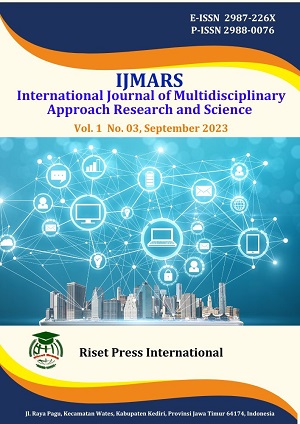Innovation of extract (Lawsonia Inermis L) as alternative dye for Escherichia Coli bacterial staining
DOI:
https://doi.org/10.59653/ijmars.v1i03.274Keywords:
Bacterial identification, Safranin, Escherichia coli, Lawsonia inermis LAbstract
Escherichia coli (E.coli) is a group of gram-negative bacteria that are part of the normal flora in the body. Under certain conditions, these bacteria can be pathogenic by producing enterotoxins that can cause serious infections such as diarrhea. Establishing the diagnosis of infection due to E.coli bacteria, namely through laboratory tests by identifying the bacteria through the bacterial staining method. So far, the most widely used bacterial dyes are synthetic dyes such as safranin. Safranin is a dye in Gram stain which can be carcinogenic and in the long run has a negative impact on health. To overcome this problem, it is necessary to innovate natural dyes that can be used as alternative dyes. Leaves of henna nails (Lawsonia inermis L.) is one of the natural ingredients which has an orange-orange lawsone pigment that is able to color the cell walls of gram-negative bacteria such as E.coli. The purpose of this study was to determine the ability of henna leaf extract (Lawsonia inermis L.) as an alternative to safranin staining. This research is a laboratory experiment. The experimental group was stained with henna leaf extract, using ethanol solvent concentrations of 25 mg/ml, 50 mg/ml, 75 mg/ml and 100 mg/ml. The control group used safranin dye. All research groups were carried out 3 repetitions. The parameters used were the clarity of the visual field, the shape of the bacteria, the cleanliness of the preparation and the color of the bacteria compared to the safranin control. The results showed that henna leaf extract was effective enough to be used as a coloring agent to replace safranin because it can color E.coli bacteria well.
Downloads
References
Chowdhury, S., Mishra, R., Kuswaha, P., & Saha, P. 2017. Removal of Safranin from Aqueous Solutions by NaOH Treated Rice Husk: Thermodynamics, Kinetics and Isosteric Heat of Adsorption. Asia Pacific Journal of Chemical Engineering, 265(1-3), 236- 249.
Edyani, JS. 2020. Systematic Review: Ultilization Of Natural Materials As An Alternative Colors To Replace Safranine In Gram Color. Publication Manuscript: 'Aisyiyah University Yogyakarta.
Hafiz, H., Chukwu, O., & Nura, S. 2017. The Potential of Henna (Lawsonia Inamis L.) Leaves Extracts as Counter Stain in Gram Staining Reaction.
Hemeg, H.A. 2018. Molecular characterization of antibiotic resistant Escherichia coli isolates recovered from food samples and outpatient Clinics, KSA. Saudi Journal of Biological Science, 25(1), 928-93
Herwin, A. H Nurung, N. I. Ambo, T. Naid. Identification of Chemical Components of Ethanol Extract of Girlfriend Leaves (Lawsonia inermis L.) As Antibacterial and Antioxidant. Journal of Microbiology Science, Vol.2 (1), Year: 2022
Kwartiningsih, E., Prastika, and Triana. 2016. Extraction and Stability Test of Super Red Dragon Fruit Peel (Hylocereus costaricensis). Proceedings of the National Seminar on Struggle Chemical Engineering.
Malekbala, M. R., Soltani, S. M., Yazdi, S. K., & Hosseini, S. 2017. Equilibrium and Kinetic Studies of Safranin Adsorption on Alkali-Treated Mangi Seed Interguments. International Journal of Chemical 13 Engineering and Application, 3(3), 160-166.
Nainggolan, M., Patilaya, P., Sumantri, I. B., Sitompul, E., & Sitorus, P. 2019. Guide and Report on Pharmaceutical Microbiology Practicum. Medan: University of North Sumatra.
Padang City Health Department. Diarrhea Data for 2018-2019 Padang: Padang City Health Service.
Praise Lestari, Titiek. 2015. Review: Sources and Utilization of Natural Dyes. The Dynamics of Crafts and Batik: Scientific Magazine, Vol. 32, No. 2.
Rahayu, W.P, S. Nurjanah, and E. Komalasari. 2018. Escherichia coli: Pathogenity, Analysis and Risk Assessment. Bogor: IPB Press
Ratnawati, D., Maryanti, E., & Sentani, A. M. 2018. Application of henna leaf extract (Lawsonia Inermis L) as a preservative and dye natural Tofu. Gradient Journal, 8(1), 739–745.
Setiana, Shella. 2015. The Effect of Concentration of Mordant Lime with Dyes of Dried Girlfriend Leaves (Lawsonia Inermis L) on Staining of Knit Cotton Fabrics Using the Tie Dye Technique. Journal of S1 Dressmaking, Vol. 4, No. 3.
Supriningrum, R., Fatimah, N., & Wahyuni, N. R., 2018. Determination of Flavonoid Levels of Ethanol Extract of Girlfriend Leaves (Lawsonia inermis L.) based on Differences in Drying Methods. Manuntung Scientific Journal, 4(2), 156-161.
Yusdiani, Devita, et al. 2016 Bacteriology. Jakarta: EGC Medical Book Publisher.
Downloads
Published
How to Cite
Issue
Section
Categories
License
Copyright (c) 2023 Niken Niken, Inelvi Yulia

This work is licensed under a Creative Commons Attribution-ShareAlike 4.0 International License.
Authors who publish with this journal agree to the following terms:
- Authors retain copyright and grant the journal right of first publication with the work simultaneously licensed under a Creative Commons Attribution-ShareAlike that allows others to share the work with an acknowledgement of the work's authorship and initial publication in this journal.
- Authors are able to enter into separate, additional contractual arrangements for the non-exclusive distribution of the journal's published version of the work (e.g., post it to an institutional repository or publish it in a book), with an acknowledgement of its initial publication in this journal.
- Authors are permitted and encouraged to post their work online (e.g., in institutional repositories or on their website) prior to and during the submission process, as it can lead to productive exchanges, as well as earlier and greater citation of published work (See The Effect of Open Access).
























